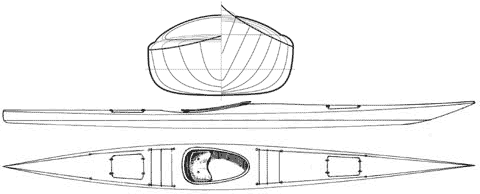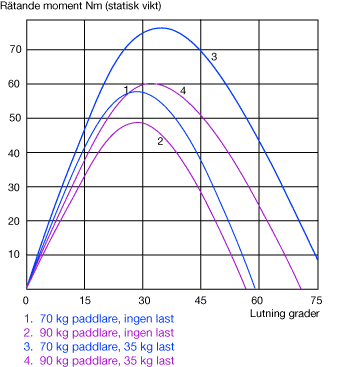Najad
Latest updated Saturday, January 4, 2025, 19 comments
Images | Particulars | More about
Plans, Najad - 166 EUR
Purchase
Najad, designed in 1998, is basically the same kayak as Nomad, despite the obvious differences in looks. The reasons for drawing Najad, was a number of requests with similar content – a rudder version of the Nomad with a higher foredeck with room for a pedal setup, a lower aft deck for layback rolls and a stern configured to fit standard rudder systems.
The configuration of the stems reduces luffing in a beam wind but it will also make it harder to turn into the wind at speed. A rudder is recommended. Packing through the cockpit is not a very good proposition with a low aft deck – I recommend that Najad is built with bulkheads and hatches.
A comment from a Norwegian builder:
"Hei Bjørn! Min Najad er ferdig! Oj, oj, oj for en båt. Den har presis de egenskapene jeg var ute etter. Hurtig ekspedisjonsbåt – konseptet fungerer perfekt. Rask, god lastekapasitet, veldig stabil, optimalisert for ror, gunstig for konkuransepadling og vingåre. Dette er en havkrysser, jeg er meget fornøyd."
(my translation:) Hello Bjørn! My Najad is finished, and whoa, what a Kayak! It has exactly the qualities I was hoping for. Fast expedition kayak – the concept works as advertised. Quick, roomy, stable, designed for rudder, excellent for competition paddling with wing paddle. Thia is an open sea cruiser, I am very happy.
...and another:
Jeg er en alminnelig fyr på 175cm og 57 år gammel, jeg padler raskere med Najad en med andre kajakker. Jeg får 12,3-12,4 km/t på Najaden når det er flatt og uten strømninger. Jeg ser da at kajakken ikke bygger bølger rundt forskipet, det ser veldig bra ut. (Under litt gunstige forhold har jeg vært over 13 km/t)
Toppfarten holder ikke lenge men jeg kan holde 9 km/t i ca. 1 mil. (8,4 i snitt på 23 km)
10 km/t går bra i ca. 1 km.
Najad er den kajakken jeg padler raskest med under alle forhold.
(my translation: I am an ordinary guy, 175 cm and 57 years old. I paddle faster in Najad than in any other kayak, reaching 12,3-12,4 km/h on flat water without currents. I can see that there are almost no bow-wave, it looks really good. In optimal conditions, I have been over 13 km/t.
That speed is of course on short distances, but I can do 10 km/h over 1 km, 9 km/t on 10 km and have done 8,4 over 23 km.
Najad is the over-all fastest kayak in different conditions.
...and one from Nya Zeeland:
The design more then lived up to expectations. The first thing I noticed was the speed of the kayak, my normal touring speed has now gone from an average of 7km per hour to 8.5km. The Najad carves a turn better then any other kayak I've paddled and despite it being a calm day it breezed through the occasional 20knt gusts with out any noticeable weather cocking even with the rudder up. The kayak also rolls well and I could do my all my GP rolls without a problem. Unfortunately I could only find boat wakes to surf today but it handled them well."
Particulars

A narrower version – 52/50 cm – is available for those who want even more exciting perfomance. Specify when ordering.
| Length¹ |
580/541 cm (overall/WL) |
| Beam |
55/53 cm (overall/WL) |
| Draft |
11 cm |
| Cockpit¹ |
80x40 cm |
| Height¹ |
28.5/20 cm (in front of/behind the cockpit) |
| Weight² |
17-23 kg |
| Displacement/volume⁶ |
150 kg/400 litre |
| Speed³ |
7.8/11.1 km/h |
| Prismatic coefficient |
0.57 |
| Wetted surface |
2.31 m² |
| Drag⁴ |
1.7/3.08 kp |
| Stability⁵ |
4/5 (initial/secondary stability) |
| Intended use |
Expedition and touring, coastal and deep sea. Day tours and exercise. |
* These dimensions can be adapted to suit personal needs or wishes.
** Depending on type of wood, equipment, care with epoxy usage, sanding etc. etc.
*** The speed numbers are based on mathematical standard formulas (175 lb paddler + 30 lb carco weight) and corrected from the kayaks actual performance om trials, on tours and in races.
⁴ Calculated resistance in 4 and 5 knots (at nominal load capacity).
⁵ Initial stability and secondary stability on a subjective scale, where 1 is very tippy and 5 is very stable.
⁶ Displacement is kayak + paddler + load. Count off the kayak weight to get the load capacity.

Stability
The curve shows the calculated stability with a static load, and therefore of limited use for a real paddler. The part of the curve near zero degrees indicates the initial (primary) stability – the steeper the curve, the more stable. The part of the curve left of the peak indicates end (secondary) stability – the higher and wider, the safer you feel edging the kayak. The position of the peak shows also how much the kayak can be leaned without tipping over. The part of the curve to the right of the peak with rapidly decreasing righting moment is almost impossible to take advantage of.
Plans
The plan sheets contain the information needed to build the kayak/canoe. Station molds, stems and construction details are full scale. For kayaks the recommended cockpit size is shown half scale with offsets for a full scale drawing and advice on altering the size. On the plans you will also find advice on how to shorten or lengthen the craft. Lines and construction drawings are in metric scale 1:10.

 The illustrated step-by-step building manual is in Swedish only, but it is available online in English: it covers all steps in detail and will guide first-time builders through the project.
The illustrated step-by-step building manual is in Swedish only, but it is available online in English: it covers all steps in detail and will guide first-time builders through the project.
Plans, Najad - 166 EUR
Purchase
Minimum window dimensions to get your kayak out from the workshop:
56x30cm

